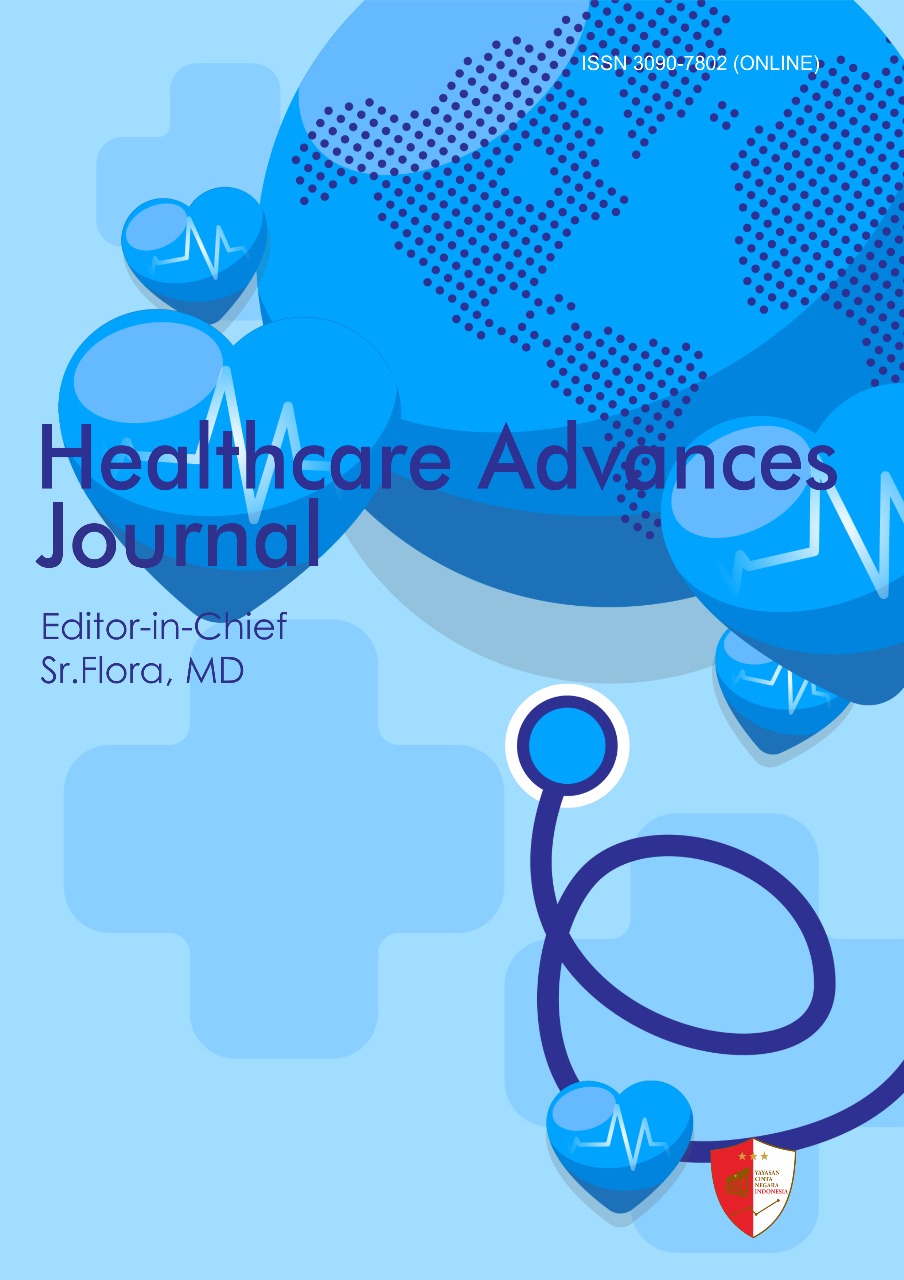Analysis of Outpatient Compliance with Antibiotic Use at the Pulmonary Polyclinic of HKBP Balige Hospital
Keywords:
Pulmonary Clinic, Antibiotic Resistance, Antibiotic Use, Outpatient Compliance, Patient AdherenceAbstract
Antibiotic compliance in Indonesia remains a significant concern, as improper dosage and duration of therapy contribute to the growing problem of antibiotic resistance. Patient adherence plays a crucial role in preventing this issue. This study aims to assess the level of patient compliance with antibiotic usage at HKBP Balige Hospital. Employing a descriptive research design, the study presents a percentage-based analysis of compliance levels among patients receiving antibiotic therapy. Data were collected from 60 respondents. The results indicate that 59.10% of patients demonstrated adherence to prescribed antibiotic regimens, while 40.90% were non-compliant. These findings categorize the overall level of antibiotic compliance at HKBP Balige Hospital as satisfactory. The study recommends that HKBP Balige Hospital continue to enhance its pharmaceutical services, particularly in delivering comprehensive drug-related information to patients to further improve compliance and mitigate the risk of resistance
References
Adriaenssens, N., Coenen, S., Versporten, A., Muller, A., Minalu, G., Faes, C., ... & Goossens, H. (2011). European Surveillance of Antimicrobial Consumption (ESAC): outpatient antibiotic use in Europe. The Journal of Antimicrobial Chemotherapy, 66(6), 11–19.
Ahmed, S. M., Nahiduzzaman, K. M., & Hossain, A. (2020). Patient compliance and antibiotic misuse: A global health threat. Global Health Research and Policy, 5(1), 1–9.
Alrasheedy, A. A., Alsalloum, M. A., Almuqbil, F. A., Almalki, A. A., Alfahad, I. A., Alharbi, A. A., & Hassali, M. A. (2020). Knowledge, attitude and practice about antibiotic use and resistance among medical students in Saudi Arabia. Saudi Pharmaceutical Journal, 28(5), 595–602.
Amstrong, D. (2012). A survey of antibiotic use and patient compliance. Journal of Infection and Public Health, 5(4), 249–258.
Aslam, B., Wang, W., Arshad, M. I., Khurshid, M., Muzammil, S., Rasool, M. H., ... & Baloch, Z. (2018). Antibiotic resistance: a rundown of a global crisis. Infection and drug resistance, 11, 1645–1658.
Azwar, S. (2010). Metode Penelitian. Yogyakarta: Pustaka Pelajar.
Badan Penelitian dan Pengembangan Kesehatan. (2018). Laporan Riset Kesehatan Dasar (Riskesdas). Kementerian Kesehatan RI.
CDC. (2019). Antibiotic Resistance Threats in the United States, 2019. U.S. Department of Health and Human Services.
Chambers, H. F. (2017). The changing epidemiology of Staphylococcus aureus. Emerging Infectious Diseases, 17(3), 420–426.
Chakrabarty, A. M. (2018). Antibiotics and antibiotic resistance: the other side of the coin. Springer.
Charan, J., & Biswas, T. (2013). How to calculate sample size for different study designs in medical research. Indian Journal of Psychological Medicine, 35(2), 121–126.
Coenen, S., Ferech, M., Haaijer-Ruskamp, F. M., & Goossens, H. (2007). European Surveillance of Antimicrobial Consumption (ESAC): quality indicators for outpatient antibiotic use in Europe. Quality and Safety in Health Care, 16(6), 440–445.
Csikszentmihalyi, M. (2011). Flow: The Psychology of Optimal Experience. Harper Perennial.
Dyar, O. J., Obua, C., Chandy, S., & Pulcini, C. (2016). Using antibiotics responsibly: are we there yet. Future Microbiology, 11(8), 1057–1071.
Foxman, B. (2010). The epidemiology of urinary tract infection. Nature Reviews Urology, 7(12), 653–660.
Garbe, E., Suissa, S., & LeLorier, J. (2023). The impact of antibiotic use on resistance patterns. International Journal of Clinical Pharmacy, 45(2), 212–221.
Ghozali, I. (2018). Aplikasi Analisis Multivariate dengan Program IBM SPSS 25. Semarang: Badan Penerbit Universitas Diponegoro.
Hadi, U., & Duerink, D. O. (2010). Audit of antibiotic prescribing in two governmental teaching hospitals in Indonesia. Clinical Microbiology and Infection, 16(5), 568–574.
Hidayat, R. (2021). Farmasi Sosial: Teori dan Aplikasi Praktik di Pelayanan Kesehatan. Jakarta: EGC.
Kemenkes RI. (2020). Petunjuk Teknis Penggunaan Antibiotik Rasional di Fasilitas Kesehatan. Jakarta: Direktorat Pelayanan Kesehatan Primer.
Kotwani, A., Wattal, C., Joshi, P. C., & Holloway, K. (2016). Irrational use of antibiotics and role of the pharmacist: an insight from a qualitative study in New Delhi, India. Journal of Clinical Pharmacy and Therapeutics, 41(4), 459–462.
Lestari, T. W., & Utami, D. A. (2019). Kepatuhan Penggunaan Antibiotik pada Pasien Rawat Jalan. Jurnal Ilmu dan Teknologi Kesehatan, 6(1), 55–61.
Llor, C., & Bjerrum, L. (2014). Antimicrobial resistance: risk associated with antibiotic overuse and initiatives to reduce the problem. Ther Adv Drug Saf., 5(6), 229–241.
Livermore, D. M. (2004). The need for new antibiotics. Clinical Microbiology and Infection, 10, 1–9.
Mulyati, S., & Yuliani, R. (2020). Evaluasi Rasionalitas Penggunaan Antibiotik. Jurnal Farmasi Galenika, 6(2), 153–160.
Munro, S. A., Lewin, S. A., Smith, H. J., Engel, M. E., Fretheim, A., & Volmink, J. (2007). Patient adherence to tuberculosis treatment: a systematic review. BMC Public Health, 7(1), 1–14.
Notoatmodjo, S. (2012). Promosi Kesehatan dan Ilmu Perilaku. Jakarta: Rineka Cipta.
Nugroho, H. S. W. (2021). Statistik untuk Penelitian Kesehatan. Yogyakarta: Andi.
O’Neill, J. (2016). Tackling Drug-Resistant Infections Globally: Final Report and Recommendations. Review on Antimicrobial Resistance.
Palupi, I. R., & Sari, P. (2020). Analisis Kepatuhan Pasien terhadap Terapi Antibiotik. Jurnal Kefarmasian Indonesia, 10(2), 140–146.
Paterson, D. L. (2006). Resistance in gram-negative bacteria: Enterobacteriaceae. American Journal of Infection Control, 34(5), S20–S28.
Pradipta, I. S., & Tjaniadi, M. (2019). Antibiotik dan Resistensinya. Jurnal Ilmu Kefarmasian Indonesia, 17(1), 34–42.
Rahmawati, F., & Wijayanti, R. (2019). Analisis Faktor yang Mempengaruhi Kepatuhan Pasien. Jurnal Keperawatan, 7(2), 112–117.
Rawson, T. M., Moore, L. S., Hernandez, B., Charani, E., Castro-Sanchez, E., & Holmes, A. H. (2016). A systematic review of clinical decision support systems for antimicrobial management. Journal of Antimicrobial Chemotherapy, 72(2), 289–298.
Ritchie, H., & Roser, M. (2019). Antibiotic Resistance. Our World in Data. https://ourworldindata.org/antibiotic-resistance
Rizki, R. N., & Hanum, F. (2021). Studi Kepatuhan Pasien dalam Penggunaan Antibiotik. Jurnal Farmasi Sains dan Praktis, 7(1), 25–30.
Shehadeh, M., Suaifan, G., Darwish, R. M., Wazaify, M., Zaru, L., & Alja'fari, S. (2012). Knowledge, attitudes and behavior regarding antibiotics use and misuse among adults in the community of Jordan. Saudi Pharmaceutical Journal, 20(2), 125–133.
Spellberg, B., Bartlett, J. G., & Gilbert, D. N. (2013). The future of antibiotics and resistance. New England Journal of Medicine, 368(4), 299–302.
Waaseth, M., Adan, A., Røen, I. L., Eriksen, K., Stanojevic, T., Halvorsen, K. H., & Granas, A. G. (2019). Knowledge of antibiotics and antibiotic resistance among Norwegian pharmacy customers. BMC Public Health, 19(1), 66.
WHO. (2015). Global Action Plan on Antimicrobial Resistance. Geneva: World Health Organization
Downloads
Published
Issue
Section
License
Copyright (c) 2025 Sheren Dhita, Tari Pradipta (Author)

This work is licensed under a Creative Commons Attribution-NonCommercial 4.0 International License.





